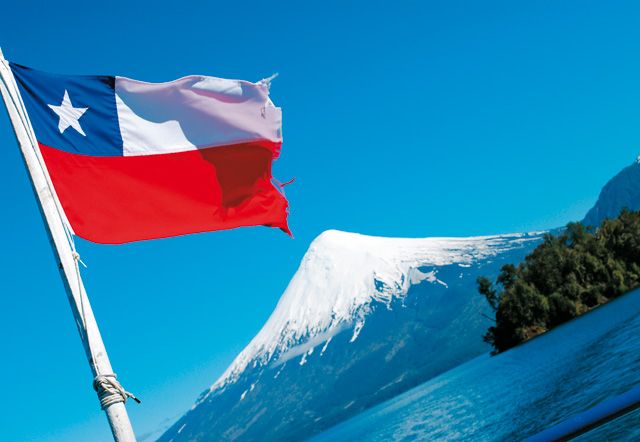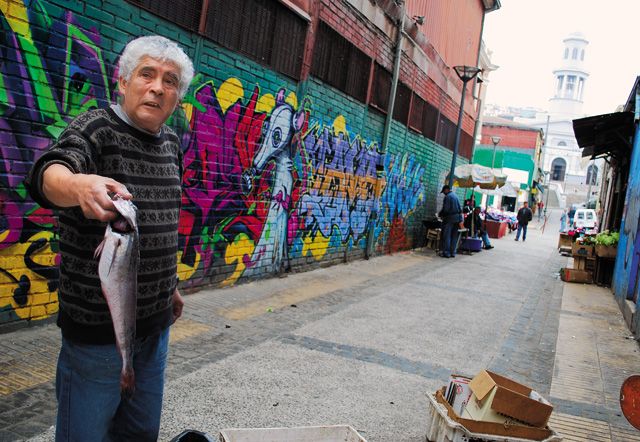Chilean cowboys decked out in ponchos, hats and boot spurs encircle girls in gypsy floral dresses over the cold cobbles of the Plaza de Armas in central Santiago, a few blocks away from the icy and swollen Mapuche River. This was once the site of a Spanish weapons store, but nowadays the only thing that goes off with a bang is the tension between the performers of Chile's national dance.
Backed by clapping and guitars, the Cueca mimics the mating ritual of a rooster and hen - with the latter flirtatiously spurning the advances of her potential suitor, until succumbing to his charm as the beat fades in a hazy swirl of Latin passion.
Puerto Valparaiso
Away from Santiago in the portside regions, the Cueca is danced with more aggression. Girls wear shorter skirts and the men wave handkerchiefs above their heads with added vigour. It's not the only way Porteños express themselves differently to other Chileans. In Puerto Valparaiso, a quaint postcard town 120km north west of Santiago, graffiti adorns the walls of every building nestled precariously into the hillside overlooking the docks. The late Nobel Prize-winning Chilean poet Pablo Neruda, whose Valparaiso residence is now a museum, described the city as having had ‘no time to comb its hair or get dressed'. But far from meaning the place was a mess, he was probably referring to the city's carefree vibe and edgier attitude, a sense that still emanates from the ubiquitous multi-coloured brickwork.
The graffiti craze started during the 17-year reign of infamous dictator Augusto Pinochet - celebrated by some as an economic reformer, but despised by others who hold his regime responsible for the ‘disappearance' of 3,000 people.
Spray can-toting youths would take to the steep back alleys at night to draw out messages of protest under anonymity for fear of falling foul of the system. Back then, it was the only forum for free speech.
Nowadays, it's not anonymous and more about the art than politics. Murals change on a monthly basis and it's not uncommon to see a graffiti artist in bohemian alpaca woollies out spraying the side of an old lady's corrugated iron shack in broad daylight while she brews him a cuppa.
All above board, homeowners assign artists via word-of-mouth. The most popular is CharquiPunk, an artist who has carved out quite a name for himself as Chile's very own Banksy. If you take a walk around the maze of spilt paint-pot back alleys, perhaps you'll find him. For its source of inspiration for the nation's wider art scene of literature, poetry, philosophy and music, Valparaiso has come to be recognised as Chile's cultural capital. The city has also been granted Unesco world heritage status - an accolade not exclusive to its artwork but also for Valparaiso's rich historic significance as the strategic port that time forgot, with 1960s trams still trundling by.
Santiago
Santiago has a healthy hand in the historical stakes as well. A tour of the capital is a fascinating insight into the spirit of the modern Chilean. Palacio de La Moneda, the government palace, is famous for being the building besieged during the 1973 military coup. It was here that Salvador Allende, Chile's left-wing socialist leader, was overthrown by Pinochet, his interior minister. Allende apparently committed suicide inside as tanks surrounded the building. His last words were broadcast over state radio: "May you go forward in the knowledge that, sooner rather than later, the great avenues will open once again, along which free citizens will march in order to build a better society."
Nowhere has that sentiment been achieved in Chile quite as evidently as the streets of Santiago. Taking a brisk walk, overshadowed by gothic and colonialist-styled cathedrals and universities, the bubbling, diverse and welcoming community will raise the hairs on the back of your neck. Especially as you remember Allende's words over the crackling airwaves. The Chileans maybe aren't as in-your-face as other South Americans but they're by no means cold or aloof either.
The real flavour of the place can be felt at Barrio Bella Vista, where a variety of restaurants and clubs feed the city's almost daily need to kick back and relax. Tucking into flaky Patagonian salmon with streaks of locally-grown avocado, you can move on to sample some Salsa dancing, but don't arrive anywhere around here before midnight. Things take longer to kick-off, and once they're started, you'll be throwing an all-nighter.
At sunrise, you could walk up a nearby hill to the statue of the Immaculate Conception for panoramic views of the Santiago Valley, squished between the snow-capped Andes and the coastal ranges.
There's a certain romance to Santiago. Like the sight of young lovers carving their names into the leaves of palm trees atop the Cerro Santa Lucia. This mustard-coloured twin stairwell arching over a fountain of Neptune takes you up into a turret above the blossoms for a downtown view.
There's a saying that "Santiago is Chile", but frankly, no one place can epitomise a nation of such fragmented influences. The geographical diversity - from the Mexican desert right down to the Norwegian fjords and Swiss glaciers, with Californian beaches, French vineyards and Italian ski slopes in between - gives Chile a different culture for every square kilometre.
Sometimes that margin is even narrower. Wheel chains used by drivers to traverse icy conditions heading up the hills to Valle Nevado Ski Resort, some 60km from Santiago, were being hung on snow-caked cactus plants mid-way up the mountain. A reminder, if needed, that when the June to October ski season ends, another colour and climate awaits the opportunity to re-emerge from the shadows.
Puerto Montt
On the other hand, the seasons in Patagonia stay pretty much the same. Rain and bitter cold prevail in Puerto Montt, the gateway to southern exposure, 1,020km south of the capital, Santiago. Here, German colonies have isolated themselves so much since moving from their true origins centuries ago, that it's like a Central European time-warp, with its rolling green hills and bright blue rivers, the roaming ground of llama, alpaca and wild salmon.
Entire townscapes look lifted from a Swiss chocolate box lid, especially with their wood-burning chimneys and toy town-hued oak panelled chapels all huddled between the valleys. Not only is this region famous for a mention in a Manic Street Preachers song, Ready for Drowning, which asks the poignant question, "where are we going?" it's also the sole topic of the ingenious and somewhat infamous British travel writer Bruce Chatwin's 1977 debut novel: In Patagonia.
Seemingly, the place to be for those seeking to find themselves, it's easy to get room to breath in the expansive glacial lakes and waterfalls of the Los Lagos region. If you can't find an answer to your questions in the rippled reflections of Mount Osorno and Puntiagudo cast across Lagos Todos Los Santos, there probably isn't one.
This is the heart of the Vicente Perez Rosales National Park and only the start of Patagonia proper. Earmarked as a Lord of The Rings filming location, it lost out to New Zealand, meaning the mystery of the place remains hidden - like the Inca trading trails that carried on for centuries behind the backs of Spanish settlers.
So, for a narrow strip of land at the end of the world, only really famous in the travelling fraternity for its Easter Island association, it may be news to some that mainland Chile too, more than justifies a visit. Just like the Cueca dance, it's guaranteed to win you over in the end.
How to get there...
Air France KLM flies to Santiago via Paris. The cheapest flights we found in October were roughly Dh2,740 each way. Flights are twice daily out of Dubai and five times a week from Paris direct to Santiago. Paris has a daily route to Sao Paulo with a connection if you prefer. The flight takes roughly 18 hours.
Contact: 04-602-5400
Where to crash
Puerto Valparaiso's Hotel Zero is a traditional town house turned boutique city stop-over with seaviews and funky furnishings. www.zerohotel.com,Dh1,000 per night.








